Fred Hoyle An observer of the world and a ponderer on its problems ...
With Chandra Wickramasinghe
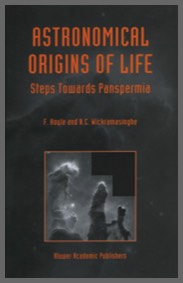
PREFACE
Living material contains about twenty different sorts of atom combined into a set relatively simple molecules. Astrobiologists tend to believe that abiotic material will give rise to life in any place where these molecules exist in appreciable abundances and where physical conditions approximate to those occurring here on Earth. We think this popular view is wrong, for it is not the existence of the building blocks of life that is crucial but the exceedingly complicated structures in which they are arranged in living forms. The probability of arriving at biologically significant arrangements is so very small that only by calling on the resources of the whole universe does there seem to be any possibility of life originating, a conclusion that requires life on the Earth to be a minute component of a universal system. More
Some think that the hugely improbable transition from non-living to living matter can be achieved by dividing the transition into many small steps, calling on a so-called 'evolutionary' process to bridge the small steps one by one. This claim turns on semantic arguments which seek to replace the probability for the whole chain by the sum of the individual probabilities of the many steps, instead of by their product. This is an error well known to those bookies who are accustomed to taking bets on the stacking of horse races.
But we did not begin our investigation from this point of view. We began by attempting to understand the data on the scattering and absorption of starlight by interstellar dust particles. As the observations improved over the years we were led gradually to a cosmic view of the origin of life, led first to clear evidence that a major fraction of the dust is of an organic composition and then to the result that the dust actually contains a component in the form of bacteria. Much of this work appeared in the Cardiff Blue Preprint Series and was later published in journals, mainly in Astrophysics and Space Science.
Microorganisms reproduce themselves at astonishing rates when the physical and chemical conditions are favourable, so great indeed that there is no difficulty in seeing how the entire universe could be suffused by microbial life. Those with a dislike for this conclusion often argue that interstellar microorganisms would be destroyed ultraviolet light from stars. But there are several effective replies. First, organisms are not so much destroyed by ultraviolet as deactivated. Their genetic arrangements survive, and reactivation can be achieved simply by a redirecting of the switching of thymine bonds. Second, microorganisms are easily shielded against ultraviolet light. Indeed molecular clouds in the galaxy are highly effective in this respect, both in cutting out the glare of ultraviolet radiation and permitting the growth of protective mantles around the bacterial particles. And third, the replicative power of microorganisms is so great that only a minute fraction of them are required to survive in each generation. These replies seem collectively more than adequate to answer this objection.
With the genetic components of life distributed widely throughout the universe, it is a matter for each local environment to pick out the arrangements that fit the particular circumstances. In a case like the Earth a complicated fitting together of the components has occurred over the last several hundred million years, by a process which biologists refer to as evolution. However the basic genes have not been produced here. For those who believe otherwise there are problems. The interclass differences between bears and horses are much greater than the interspecies differences among bears and horses taken separately. Yet it is the latter that dominate the fossil record. Because the latter have indeed occurred on the Earth, whereas the genes responsible for the class differences of bears and horses have been externally driven and the record of their origin is not local.
Cardiff, July 1999
Fred Hoyle
Chandra wickramasinghe

The Case for a Cosmic Heritage?
Fred Hoyle and Chandra Wickramasinghe have again combined forces to write a book that is not just highly topical but in its broad sweep provides an insight into the origin and development of life and our place in the Cosmos.
This highly readable book expounds in a logical and scientific manner the radical idea that life did not originate on Earth, but was added to it from comets. When Fred Hoyle and Chandra Wickramasinghe first made this proposal in the 1970s they did not have many takers for the simple reason that the theory flew in the face of established beliefs. In recent years, however, evidence to support this theory has accumulated from many different directions and grown to the point of being compelling. Today we know that there are polyaromatic hydrocarbons in space, the amino acid glycine is present in a molecular cloud, organic dust with absorption properties similar to bacteria has been detected in comets, as well as in interstellar space.
Furthermore, cometary dust with an organic composition is known to be entering the atmosphere at the rate of some tens of tonnes per day.
Last August NASA scientists stunned the world by announcing that there was strong evidence for microbial fossils in a Martian meteorite. The most rational explanation for these facts and many more is offered in this book: life is a cosmic phenomenon, microbial life pervades the galaxy and indeed the entire Universe. The comet of the century, comet Hale-Bopp, that graced our skies so magnificently in recent weeks must serve to remind us not only of our cosmic heritage but also of our fragility should pieces of such comets strike the Earth, as they must inevitably do from to time.
This book is a 'must' for all readers interested in general science, the origin of man and the meaning of life. Foreward
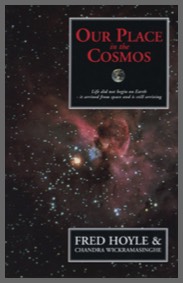
Life did not begin on Earth - it arrived from space and is still arriving.
The assumption that life originated in some virus-like form and simply evolved by natural selection into the diversity of forms known to have existed, is as Earth-centred and unenlightened as ancient astronomy. It is exactly this stringent focus on the Earth as centre-of-the-universe that is endangering the entire planet. From this controversial standpoint, the famous and respected partnership of Fred Hoyle and Chandra Wickramasinghe examines how it is overwhelmingly likely that life originated outside the solar system.
Using virological and epidemiological evidence to substantiate their theory that life is a cosmic phenomenon, the authors also assert that life-forms from space are constantly arriving to mingle with our own biosphere. The spread of the Black Death, incidences of infections such as measles and jaundice, and charts relating to the orbit of comet debris are just some of the fascinating data used to illustrate this significant new work. Prologue

The problem of the composition of cosmic dust grains has stubbornly defied solution for over half a century. A succession of models have been proposed and their properties worked out for comparison with an ever expanding body of relevant observational data. The authors began their pioneering work in this field in the 1960s by challenging the then popular ice grain theory.
Most controversially they later hypothesised that condensed organic matter in the galaxy is of biological origin, thus linking an old astronomical problem with the question of the origin of terrestrial life.
In this book the authors develop the theory of Cosmic Grains on a broad front starting logically from basic mathematical and astronomical premises. The reader is guided through a historical progression of ideas on the nature of grains, leading ultimately to the authors' own point of view, which shows through a clear predictive sequence the important role of complex organic material in the interstellar grains. Preface
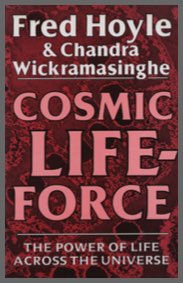
Fred Hoyle and Chandra Wickramasinghe are two of the greatest innovators of our time in scientific ideas. In the last few years they have put forward their own theories of the extraterrestrial origin of life, of the way viruses and bacteria spread disease and of the manner in which life evolves under extraterrestrial influence. Their ideas have always aroused intense controversy and invariably give a new direction to scientific research.
They propose, in their startling new theory, that the universe as a whole is controlled by an intelligent life-force that overcomes all other forces of nature. The cosmic life-force moulds the fabric of the universe to suit its own ends and harnesses the physical resources of nature. Applying their theory first to the Earth, the authors move outwards to the neighbouring planets and their satellites, and beyond them to other galaxies.
The cosmic life-force is shown to be in total control of the universe, with power to communicate across immense distance scales. Introduction
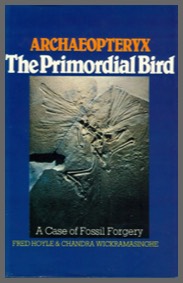
The dateline is Papenheim, Bavaria, 1861. A news story that shakes the World of museum experts: it is the discovery of a 160 million-year-old fossil of a feathered reptile supposedly found sprawling within a split block of limestone in a Bavarian quarry.
This event occurred scarcely a year after Darwin's publication of 'The Origins of Species', and only weeks after a famous Evolution versus Creation debate in Oxford where Bishop Wilberforce is alleged to have asked T. H. Huxley, Darwin's 'Bulldog', whether he thought he was descended from the ape on his grandmother's side or his grandfather's side. The memory of this debate was still fresh in everyone's minds, as was the fact that a major issue causing some consternation that came up here related to the lack of fossil evidence for intermediate forms.
The Papenheim news seemed to fill an important gap, supplying to the delight of evolutionists, a fossil form intermediate between reptiles and birds. Despite rumblings from German experts that this new fossil was a forgery, the then Director of the British Museum, Richard Owen, commissioned the purchase of the fossil without even seeing it for himself.
A detailed photographic examination of the London fossil has now revealed it to be an unquestionable forgery. This evidence is presented here, including twenty startling photographic plates, some in colour. In this scientific detective story, inviting to both the layman and expert alike, the forgery is not only exposed by the authors, but also the culprit and his motive are discovered.
This book develops the stunning proposition that viruses and bacteria responsible for epidemic diseases of plants and animals arrive from space. Epidemics of such diseases as influenza and legionella appear to be clearly driven from space with no evidence of person to person transmission. Even for the obviously 'infectious' diseases like small-pox the causative virus according to this theory comes in the first instance from space and then proceeds to establish a reservoir for person to person infection. New evidence is presented to support this general point of view with earlier essays by the authors appended to make a gripping scientific story.
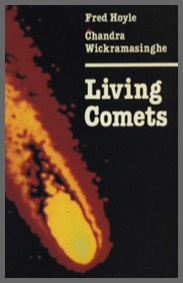
The authors interpret the latest observational data on comets to debunk the usual theory that comets are icy snow balls. All the evidence now points to an organic composition of comets. This book develops the organic comets thesis and further explores the theory that comets carry living micro-organisms to the Earth. This provocative discussion would seem timely in view of the forthcoming return of Halley's Comet in 1985/86.
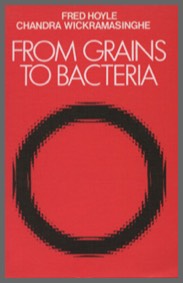
Preface
In the present volume we trace the development of our ideas on the subject of interstellar grains through a period of over two decades. The reader will find that our present views concerning the microbial nature of these grains had their origins in more or less conventional work which we began in the early 1960s. The move towards our present position occurred gradually over the years, being dictated mainly by our persistent failures to explain the relevant astronomical facts satisfactorily on the basis of more conventional grain models. A proper assessment of the microbial grain model requires, in our view, a consideration of the full range of facts as presented in this volume.
We are grateful to Professor Z. Kopal and D. Reidel Publishing Co. for permission to reproduce our papers from Astrophysics and Space Science, to the Royal Astronomical Society for similar permission to reprint from Monthly Notices, and to Mr. John Maddox and Macmillan Journals Ltd. for permission to reproduce our papers which appeared in Nature.
Fred Hoyle , Chandra Wickramasinghe, May, 1984
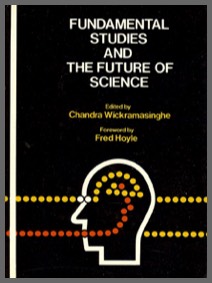
FOREWORD
This volume brings into focus fundamental enquiries in many areas of contemporary thought, mainly in science, but also in sociology and philosophy.
We live in a world where technical attainments in amassing facts relating to the Universe have reached proportions that could scarcely have been contemplated 50 years ago. Yet fundamental re-assessments of old theories, and attempts to systematise the vast body of available facts have been slower today than have ever been. This situation is fraught with danger. The need for a 'correct' world view, correct judgements on matters relating to Energy and Ecology, for instance, have come to the fore in recent years; but it is not so clear that these problems are being approached in an objective way.
In a sense it would seem that our technical attainments have run ahead of our capacity to understand them. Fundamental decisions as to what is a valid theory in Science and what is proper policy for Energy and for conquering hunger might at first sight seem unconnected, but they are not. Such decisions as these might be relevant not merely for the future of academic science, but more importantly for the very survival of our species.
On the causes of plate tectonics
Fred Hoyle 1983 p 1 -23
Interstellar Grains: Dogmas, Trends and Refutations
Fred Hoyle and N.C. Wickramasinghe 1983 p 320 - 341
The Survival of E Coli Under Extremely High Pressures
S. Al-Mufti, Fred Hoyle and N.C. Wickramasinghe p 342 - 352
The Anatomy of a Conference Epidemic
Fred Hoyle & N.C.Wickramasinghe 1983 p 386 - 390
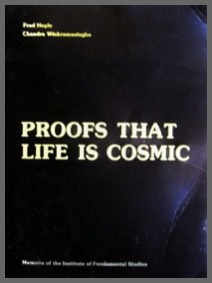
Institute of Fundamental Studies, Sri Lanka, 1
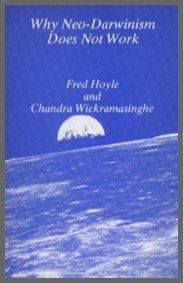
We believe we have now shown that there is a tendency in nature to the continued progression of certain classes of varieties further and further from the original type - a progression to which there appears no reason to assign any definite limits - and that the same principle which produces this result in a state of nature will also explain why domestic varieties have a tendency to revert to the original type. This progression, by minute steps, in various directions, but always checked and balanced by the necessary conditions, subject to which alone existence can be preserved, may, it is believed, be followed out so as to agree with all the phenomena presented by organized beings, their extinction and succession in past ages, and all the extraordinary modifications of form, instinct, and habits which they exhibit. - A.R. Wallace, Tenarte Essay, February, 1858 - More
This elegant qualitative description by Alfred Russel Wallace of the mechanism of evolution in 1858 was only much later to receive more quantitative expression.
Neither Wallace nor Darwin was able to define what it was that caused the 'minute steps' to occur, and it required inputs first from Mendelian genetics and later from molecular biology to assess the claims for this evolutionary mechanism. The philosophy of 'neo-Darwinism' precludes the occurrence of individual steps that are not minute, and moreover imposes the further restriction that all such steps must be derived from within terrestrial biology. We have argued elsewhere that both these constraints are incorrect (Evolution from Space, Dent, 1981). In this essay we further substantiate our objections to neo-Darwinism.
Hypotheses on genetics have been subject to frequent modification over the years, partly in relation to new discoveries in the laboratory and in the field, but more often with a view to a posteriori justification of neo-Darwinism - a mechanism that has come to be thought by many biologists to be inviolable. The model we describe below embodies what we consider to be the essential aspects of all relevant empirical data, and provides a sufficiently general framework for assessing the validity of the neo-Darwinist doctrine.
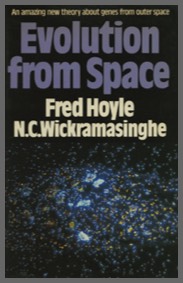
In this very important sequel to their highly successful Lifecloud and Diseases from Space, the authors turn their attention to evolution and put forward a new theory that revolutionizes our understanding of the evolutionary process. They claim that we can now explain the leaps and catastrophes that are known to have taken place over the geological eras.
They argue that the evolutionary course of life on Earth has always been subject to cosmic influences and that the biological make-up of living things on our planet is radically changed by the arrival of pristine genes from outer space. Herein lies the explanation of sudden bursts of new life forms and other dramatic developments that occur. We must now attribute not only the origin of terrestrial life but its continuing evolution to cosmic influences.
The conclusion is that the complexity of life on Earth cannot have been caused by a sequence of random processes, but must have come from a cosmic intelligence. Life had already evolved to a high standard of information long before the Earth was born, so that our planet received life with the fundamental biochemical problems already solved.
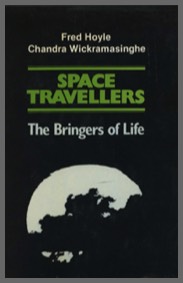
This book is one of a series in which we examine the possibility that life might be a cosmic phenomenon.
An unbiased investigator setting out to discover the truth about life's origins would see two logical paths to follow. The first path points to beginnings of life that are confined to our planet. The second, far less popular path seeks to understand life as a cosmic phenomenon, with the Earth merely playing the role of a receiving home - one amongst countless others in the Universe. There is no a priori reason for preferring anyone of these two paths, and so in the absence of further information they must each be regarded as possibilities equally to be explored. Writ In The Stars
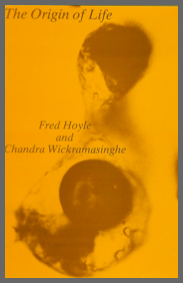
In this essay we shall discuss the question of the origin of life on our planet in a somewhat wider context than is usually thought to be necessary. First of all, we must concede that there is a logical need to understand an origin of life, at least as far as the Earth is concerned. The Earth, today, is surely teaming with life, and organic molecules exist in great abundance. But this, clearly, was not always so. Four-and-a-half billion years ago the material of the Earth was in the form of a cloud of fine dust particles that was in the process of contracting to become the primitive Earth. And for a while after the Earth had itself condensed into a solid body, its molten crust would have been too hot for any organic molecules to persist.
There are good reasons to believe that much smaller condensed bodies in the form of icy comets from the outer regions of the solar system subsequently impacted on this cooling planet and deposited volatile materials, including water, that went to form the Earth's oceans. Evaporation of water from the oceans, and the break-up of water molecules by sunlight then gave rise to an atmosphere and a cloud cover around our planet. Only after this happened could the Earth have become a suitable home for life, with its surface screened and well protected from the damaging ultraviolet radiation from the Sun.
We shall next touch briefly on a question central to the theme of this essay: could life have emerged from non-living matter here on the Earth? The production of organic molecules of rather great complexity - for example, sugars, nucleotides, amino acids - is a necessary condition for the origin of life; but the production of these substances alone are by no means enough for the origin of life. The vast majority of the organic molecules we find today on Earth are either directly or indirectly the product of biology. ...
Until now the idea that viruses and bacteria can land on the Earth from space has been looked on as at best unproven, at worst outrageous.
In their book Lifecloud, which received worldwide attention, Sir Fred Hoyle and Professor Chandra Wickramasinghe argued that life arrived on Earth from interstellar space. Now, in this even more exciting sequel, they maintain that viruses and bacteria responsible for plagues and diseases also reach our planet from space.
According to this revolutionary new theory, microbes stored deep-frozen in comets since the early history of the solar system thousands of millions of years ago have subsequently arrived on Earth - and continue to do so.
By examining the infall of pathogenic material from space and analysing plagues and epidemics, the authors have brought about a major advance in our understanding of the relation of astronomy to diseases in terrestrial animals and plants.
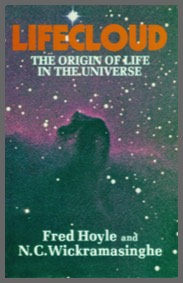
How did life in the universe begin? Is there life elsewhere? If so, what are the chances of finding or communicating with other beings?
Until recently astronomers thought that life evolved from inorganic matter in a primeval soup on the surface of our planet. This picture is now dramatically shattered. Sir Fred Hoyle and Professor Chandra Wickramasinghe introduce a revolutionary new theory that life originated in the space between the stars.
The basic chemicals of life have long existed on an astronomical scale in distant interstellar dust clouds, even after the early high-temperature phase of the solar nebula. These biochemicals, the very building-blocks of life, were assembled into primitive life forms on comet-sized planetesimal bodies that must have existed over the first few hundred million years in the history of the solar system.
When these bodies struck our planet some four billion or so years ago, the Earth received all its comparatively volatile materials - the atmosphere and oceans - and was given life itself, which was showered upon the terrestrial surface in the form of
living cells.
The theory put forward in Lifecloud marks a new era in our understanding of the universe. The authors follow through the implications for life elsewhere and probe the possibilities of space travel and the potential for communication from planet to planet, star system to star system. Introduction



